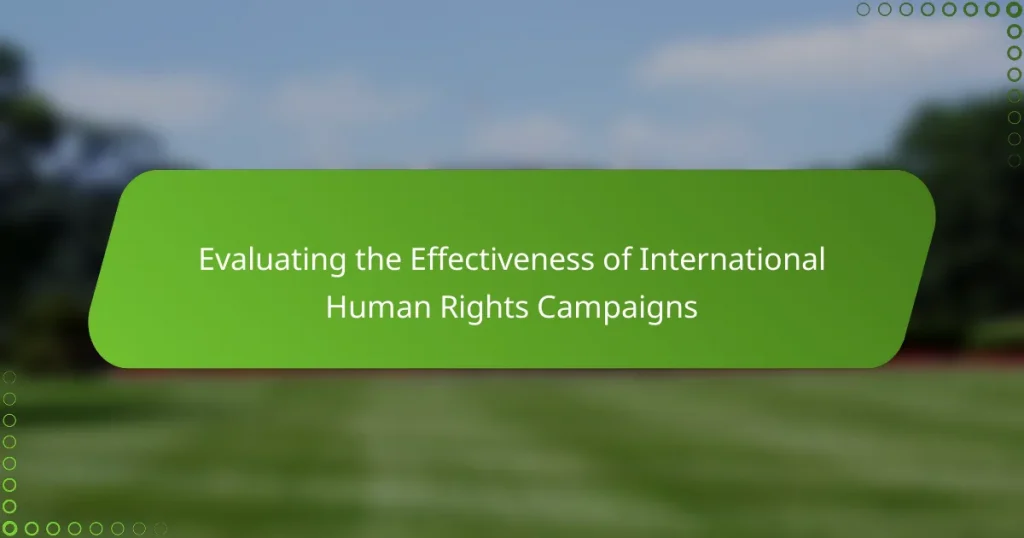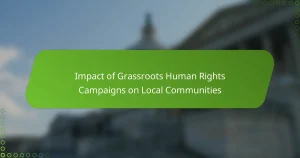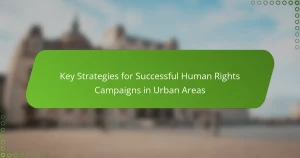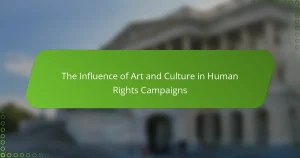International Human Rights Campaigns are organized initiatives focused on promoting and safeguarding human rights worldwide, addressing critical issues such as freedom of speech, gender equality, and the rights of marginalized groups. These campaigns engage various stakeholders, including non-governmental organizations, governments, and grassroots movements, employing strategies like advocacy, awareness-raising, and mobilization to influence public opinion and policy. The effectiveness of these campaigns is assessed through metrics such as changes in public awareness, policy shifts, and improvements in human rights conditions, with historical examples including the Anti-Apartheid Movement, the #MeToo movement, and efforts to abolish child labor. Each campaign illustrates the impact of collective action in advancing human rights and holding violators accountable.
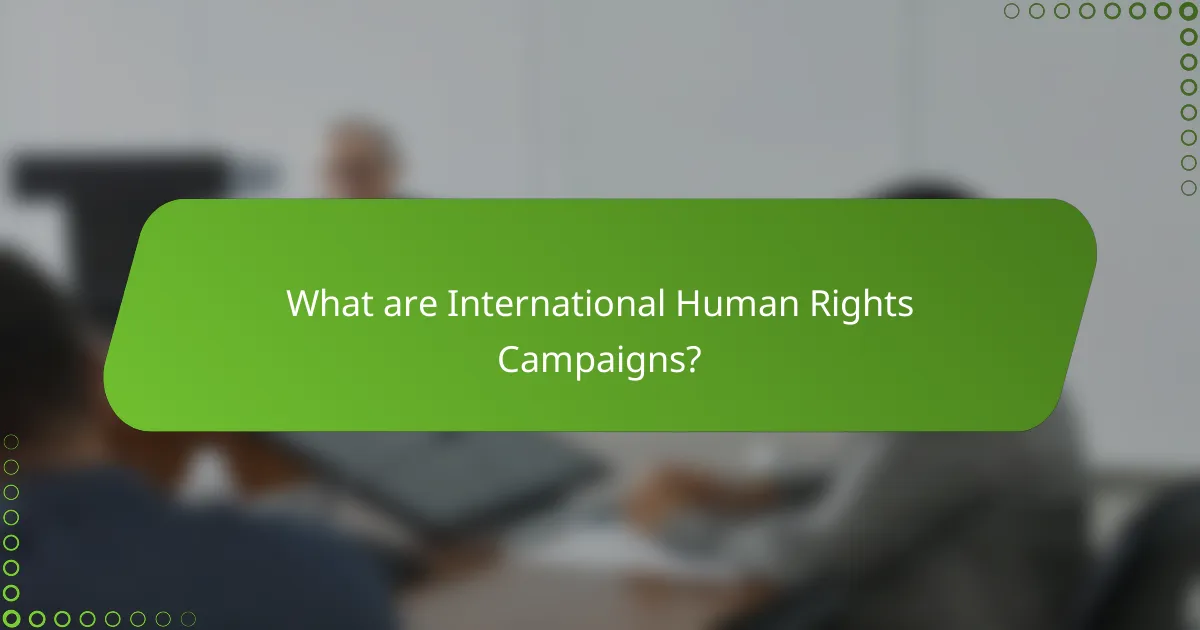
What are International Human Rights Campaigns?
International Human Rights Campaigns are organized efforts aimed at promoting and protecting human rights globally. These campaigns often address specific issues such as freedom of speech, gender equality, or the rights of marginalized groups. They involve various stakeholders including non-governmental organizations, governments, and grassroots movements. Campaigns typically utilize advocacy, awareness-raising, and mobilization strategies to influence public opinion and policy. Historical examples include Amnesty International’s campaigns against torture and Human Rights Watch’s efforts to combat child labor. These campaigns seek to hold violators accountable and promote justice and equality. Their effectiveness can be measured through changes in legislation, public awareness, and the protection of vulnerable populations.
How do International Human Rights Campaigns operate?
International human rights campaigns operate by raising awareness, advocating for policy changes, and mobilizing public support. They utilize various strategies such as social media, public demonstrations, and partnerships with local organizations. Campaigns often focus on specific issues like freedom of speech, gender equality, or refugee rights. They gather data and testimonies to highlight human rights violations. Many campaigns collaborate with international bodies like the United Nations to exert pressure on governments. Successful campaigns often lead to legislative reforms or changes in public opinion. For instance, the #MeToo movement has significantly impacted discussions around [censured] harassment globally. These campaigns rely on grassroots efforts and global coalitions to amplify their message.
What are the key components of these campaigns?
The key components of international human rights campaigns include advocacy, awareness, and mobilization. Advocacy involves promoting specific human rights issues to influence policy changes. Awareness campaigns educate the public about human rights violations and injustices. Mobilization focuses on engaging communities to take action, such as protests or petitions. These components work together to create a comprehensive approach to human rights activism. Research indicates that campaigns with strong advocacy and mobilization efforts are more effective in achieving their goals.
How do these components influence campaign outcomes?
The components of international human rights campaigns significantly influence campaign outcomes. They shape public perception, mobilize support, and attract media attention. Effective messaging resonates with target audiences, increasing engagement and advocacy. Strategic partnerships amplify reach and credibility, enhancing legitimacy. Resource allocation directly impacts campaign execution and sustainability. Data-driven approaches improve targeting and effectiveness, as shown by successful campaigns like the Ice Bucket Challenge, which raised over $115 million for ALS research. Overall, these components collectively determine the success and impact of human rights campaigns.
Why are International Human Rights Campaigns important?
International Human Rights Campaigns are important because they promote awareness and action on human rights violations globally. These campaigns mobilize public opinion and influence policy changes. They often bring attention to issues that may otherwise be overlooked. For example, the #MeToo movement highlighted [censured] harassment and assault, leading to legal reforms in various countries. Additionally, these campaigns provide a platform for marginalized voices. They help hold governments accountable for their human rights obligations. The Universal Declaration of Human Rights serves as a foundation for these efforts. Overall, they play a crucial role in advancing human dignity and justice.
What impact do these campaigns have on global human rights?
International human rights campaigns significantly influence global human rights. They raise awareness about violations and mobilize public opinion. Campaigns often lead to policy changes and increased accountability for governments. For example, the #MeToo movement has prompted legal reforms in various countries. Reports indicate that international pressure can result in improved human rights practices. The United Nations often cites successful campaigns in its annual human rights reports. These campaigns also foster solidarity among marginalized communities. Overall, they are crucial in advancing human rights on a global scale.
How do they contribute to raising awareness?
International human rights campaigns contribute to raising awareness by disseminating information about human rights issues. They educate the public on violations and injustices occurring globally. Campaigns often utilize social media, traditional media, and community events to reach diverse audiences. For instance, campaigns can generate significant online engagement, leading to increased visibility of specific issues. Research shows that campaigns can mobilize support and foster dialogue about human rights. A study by the Pew Research Center found that social media campaigns significantly increase awareness and discussion around human rights topics. By highlighting personal stories and testimonials, these campaigns humanize abstract issues. This approach encourages empathy and motivates individuals to take action.
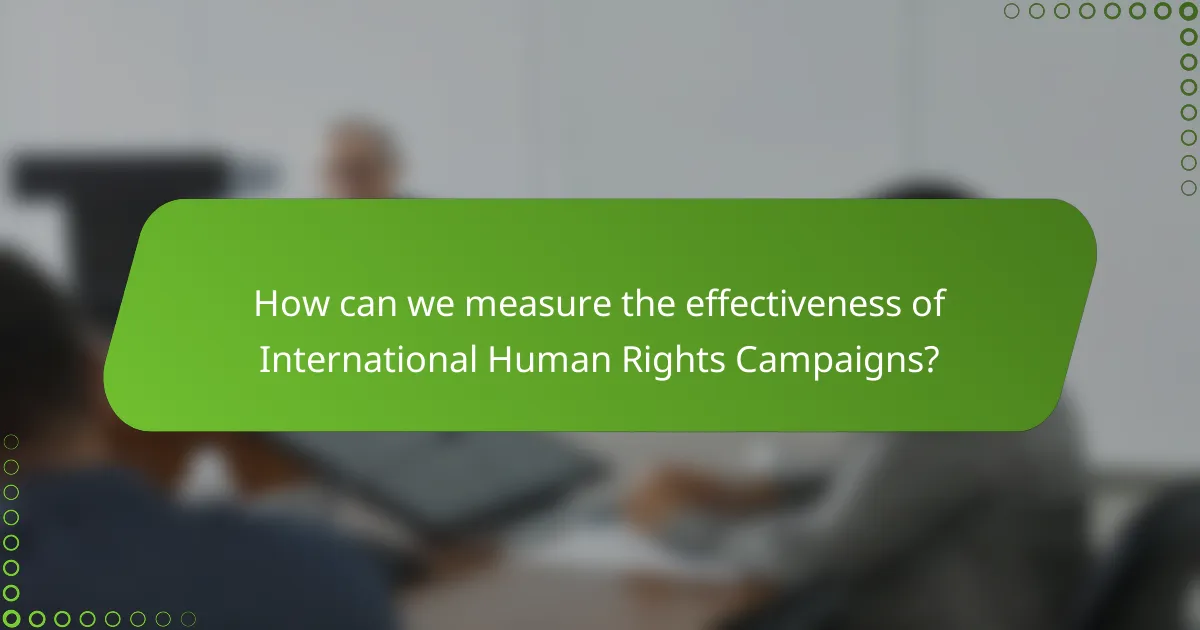
How can we measure the effectiveness of International Human Rights Campaigns?
The effectiveness of International Human Rights Campaigns can be measured through various metrics. These metrics include changes in public awareness, policy shifts, and improvements in human rights conditions. Surveys can quantify shifts in public opinion before and after campaigns. Monitoring legislative changes can indicate if campaigns influence policy. Data from human rights organizations can show improvements in conditions on the ground. For example, the Universal Periodic Review by the UN assesses countries’ human rights records periodically. Such evaluations provide concrete evidence of campaign impact.
What metrics are used to evaluate campaign success?
Metrics used to evaluate campaign success include reach, engagement, conversion rates, and impact assessment. Reach measures the number of individuals exposed to the campaign. Engagement looks at interactions such as likes, shares, and comments. Conversion rates track the percentage of individuals who take a desired action, like signing a petition. Impact assessment evaluates the campaign’s influence on policy changes or public awareness. These metrics provide a comprehensive view of a campaign’s effectiveness. For instance, a successful human rights campaign may show increased public support reflected in surveys or policy reforms.
How do qualitative and quantitative metrics differ in assessment?
Qualitative and quantitative metrics differ primarily in their approach to assessment. Qualitative metrics focus on subjective data, capturing opinions, feelings, and experiences. They provide in-depth insights into human behavior and motivations. For example, interviews and focus groups reveal personal stories that highlight the impact of human rights campaigns.
In contrast, quantitative metrics emphasize objective data, relying on numerical values and statistical analysis. They measure outcomes through surveys, polls, and existing data sets. For instance, the number of people reached by a campaign can be quantified to assess its reach.
Both metrics serve different purposes. Qualitative metrics help understand the context and depth of issues. Quantitative metrics provide measurable evidence of effectiveness. Together, they offer a comprehensive view of a campaign’s impact on human rights.
What role do public perceptions play in measuring effectiveness?
Public perceptions significantly influence the measurement of effectiveness in international human rights campaigns. These perceptions shape how campaigns are received by the audience and can affect their overall impact. Positive public perceptions can lead to increased support and engagement, enhancing the campaign’s reach and effectiveness. Conversely, negative perceptions can undermine credibility and diminish the campaign’s influence. Research shows that public opinion often correlates with the success of advocacy efforts. For instance, campaigns that resonate with societal values tend to garner more support. Thus, understanding and addressing public perceptions is crucial for evaluating the effectiveness of these campaigns.
What challenges are faced in evaluating these campaigns?
Evaluating international human rights campaigns faces several challenges. One major challenge is measuring the impact of campaigns on actual human rights improvements. Many campaigns lack clear metrics to assess their effectiveness. Additionally, the influence of external factors, such as political climate or social movements, complicates evaluations. The diversity of target audiences also makes it difficult to gauge overall success. Furthermore, the availability of reliable data can hinder accurate assessments. In some regions, data may be scarce or biased, impacting evaluation outcomes. Finally, distinguishing between short-term awareness and long-term behavioral change poses another significant challenge.
How do cultural differences affect evaluation outcomes?
Cultural differences significantly affect evaluation outcomes by influencing perceptions, values, and priorities. Different cultures may prioritize various aspects of human rights, leading to divergent evaluation criteria. For instance, collectivist cultures might emphasize community rights over individual rights, impacting how campaigns are assessed. Research shows that cultural context shapes the interpretation of success in human rights initiatives. The “Cultural Dimensions Theory” by Geert Hofstede identifies key dimensions, such as individualism versus collectivism, that can inform evaluation frameworks. Evaluators must consider these cultural attributes to ensure accurate assessments. Ignoring cultural differences can result in misleading conclusions about campaign effectiveness.
What are the limitations of current evaluation methods?
Current evaluation methods for international human rights campaigns face several limitations. They often lack standardized metrics for measuring impact. This inconsistency makes it difficult to compare results across different campaigns. Additionally, many methods rely heavily on qualitative data, which can introduce bias. Quantitative measures are often underutilized, limiting the ability to draw statistically significant conclusions. Furthermore, evaluations may not account for long-term effects, focusing instead on immediate outcomes. There is also a tendency to overlook the contextual factors influencing campaign success. Lastly, stakeholder engagement in the evaluation process is frequently inadequate, leading to incomplete assessments. These limitations hinder a comprehensive understanding of campaign effectiveness.
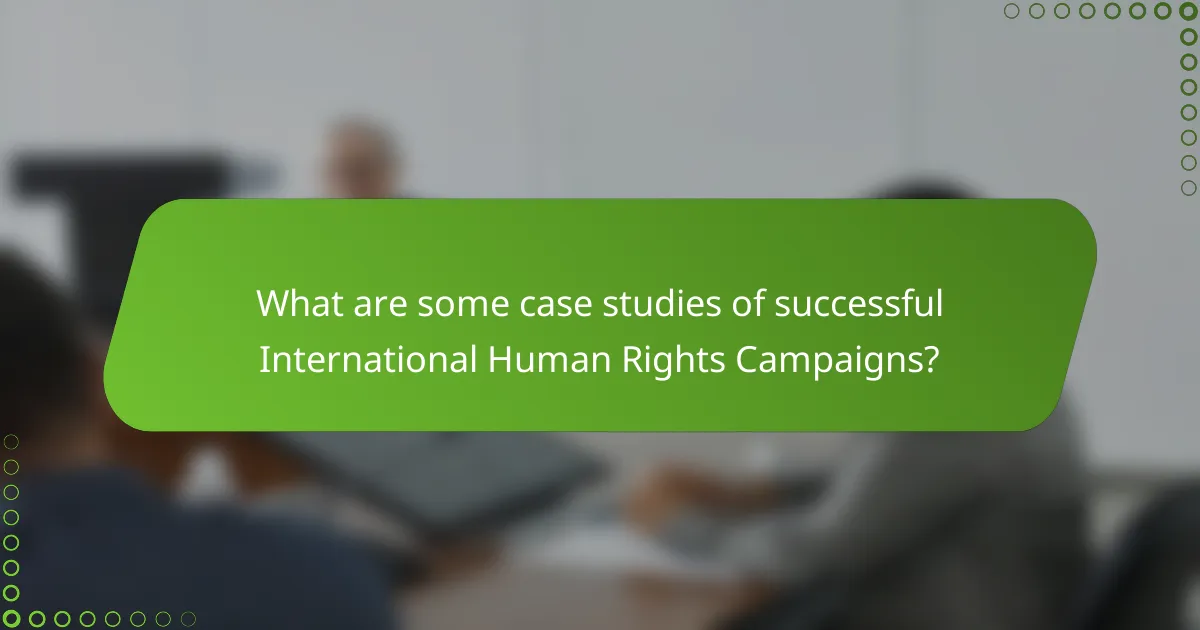
What are some case studies of successful International Human Rights Campaigns?
Successful international human rights campaigns include the Anti-Apartheid Movement, the #MeToo movement, and the campaign for the abolition of child labor. The Anti-Apartheid Movement, which gained global support in the 1980s, led to the end of racial segregation in South Africa. This campaign involved economic sanctions and widespread protests, culminating in Nelson Mandela’s release in 1990. The #MeToo movement, which began in 2017, raised awareness about [censured] harassment and assault worldwide. It empowered individuals to speak out and led to policy changes in various organizations. The campaign against child labor, particularly the Global March Against Child Labor in 1998, brought attention to child exploitation. This movement resulted in international treaties and increased enforcement of child labor laws. Each of these campaigns demonstrates the power of collective action in advancing human rights.
How did these campaigns achieve their goals?
These campaigns achieved their goals through strategic advocacy and public engagement. They utilized social media platforms to raise awareness and mobilize support. Targeted messaging resonated with diverse audiences, increasing participation. Collaborations with local organizations amplified their impact on communities. Data-driven approaches measured campaign effectiveness, guiding adjustments in real-time. Successful case studies demonstrate increased policy changes and legal reforms. For instance, the #MeToo movement led to significant legislative shifts in several countries. Overall, these campaigns effectively combined grassroots efforts with global outreach to drive change.
What strategies were employed in successful campaigns?
Successful campaigns employed targeted messaging, coalition building, and strategic use of media. Targeted messaging ensured that the campaign resonated with specific audiences. Coalition building brought together diverse stakeholders to amplify the campaign’s reach. Strategic use of media included leveraging social media platforms to engage supporters and spread awareness. For instance, the #MeToo movement effectively utilized Twitter to mobilize millions. Additionally, emotional storytelling was used to humanize issues and foster empathy among audiences. Research shows that campaigns with clear calls to action see higher engagement rates. Overall, these strategies contributed to the effectiveness of international human rights campaigns.
What lessons can be learned from these case studies?
Lessons from these case studies highlight the importance of strategic messaging. Effective campaigns often use clear, relatable narratives to engage audiences. They also demonstrate the need for collaboration among diverse stakeholders. Building coalitions can amplify impact and reach. Additionally, measurable goals are crucial for assessing progress. Campaigns that track their outcomes can adapt strategies effectively. Finally, sustained advocacy is essential; short-term efforts may not yield lasting change. These insights underscore the multifaceted approach required for successful human rights campaigns.
What best practices can enhance the effectiveness of future campaigns?
To enhance the effectiveness of future campaigns, organizations should prioritize clear messaging. Clear messaging ensures that the campaign’s goals are easily understood by the target audience. Engaging storytelling can also make the campaign more relatable and impactful. This approach helps to connect emotionally with supporters and potential allies.
Utilizing data-driven strategies improves campaign targeting. Research shows that campaigns using analytics can increase engagement by up to 50%. Regularly assessing and adapting strategies based on feedback is crucial. This allows campaigns to remain relevant and responsive to changing circumstances.
Collaboration with local organizations can amplify reach and credibility. Partnerships can provide valuable insights and resources. Additionally, leveraging social media platforms can enhance visibility. Statistics indicate that campaigns utilizing social media effectively can reach millions of users within days.
Lastly, setting measurable goals allows for better evaluation of success. This practice enables organizations to identify what works and what doesn’t. By implementing these best practices, future campaigns can achieve greater impact and effectiveness.
How can stakeholders collaborate more effectively?
Stakeholders can collaborate more effectively by establishing clear communication channels. Regular updates and feedback loops enhance transparency. Setting shared goals aligns efforts and fosters teamwork. Utilizing collaborative tools can streamline workflows and document progress. Engaging in joint training sessions builds skills and understanding. Regular meetings facilitate relationship building and conflict resolution. Research shows that organizations with strong stakeholder collaboration achieve 30% better outcomes (Source: “The Power of Collaboration,” Harvard Business Review, authors: Patrick Lencioni, et al.).
What innovative approaches can be adopted for greater impact?
Innovative approaches for greater impact in international human rights campaigns include leveraging technology and data analytics. Utilizing social media platforms can amplify voices and reach wider audiences. Data-driven storytelling enhances engagement by presenting compelling narratives supported by statistics. Collaborative partnerships with local organizations can foster trust and ensure cultural relevance. Interactive campaigns encourage public participation, driving grassroots support. Virtual reality experiences can create immersive awareness of human rights issues. These methods have shown increased visibility and mobilization in various campaigns, proving effective in raising awareness and driving action.
International Human Rights Campaigns are organized efforts that promote and protect human rights globally, addressing issues such as freedom of speech and gender equality. This article evaluates the effectiveness of these campaigns by examining their operational strategies, key components, and impact on public awareness and policy changes. It also discusses the metrics used for assessment, challenges in evaluation, and successful case studies, highlighting best practices and innovative approaches for enhancing future campaigns. Understanding these elements is crucial for advancing human rights and ensuring accountability for violations.
